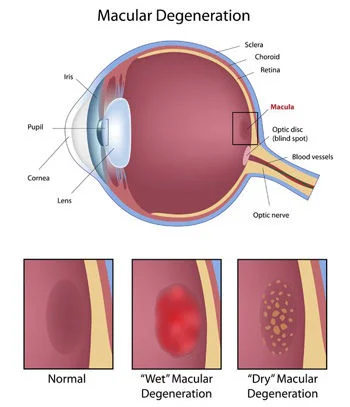Age-related macular degeneration (AMD)
What is?
AMD occurs, when a critical region of the retina, called the macula, is damaged or (deteriorating). The macula is an oval, pigmented spot near the center of the retina, responsible for high-resolution vision. The retina is a layer (of cells that is located) at the back of the eye that is sensitive to light. It sends (images) of what the eyes sees to the brain. This disorder leads to irreversible loss of central vision, although peripheral vision is retained.

There are two types of macular degeneration:
Dry AMD (or “atrophic” AMD) is the more common subtype, affecting about 90% of people, who have this condition. A small minority has the wet (or “exudative”) form that often affects people, who have a previous history of dry AMD.
Causes
Dry AMD is caused by aging and thinning of the macula. This allows drusen material (waste material from retinal cells) to accumulate under the retina.
Wet AMD occurs, when abnormal blood vessels start growing under the retina.
Risk factors
You have a higher risk for AMD, if you are over the age of 60, smoke, are obese, have hypertension, have a genetic predisposition or are of female gender.
Diagnosis
Your ophthalmologist is likely to carry out a funduscopy (examination of retina) after pupillary dilatation. Classification of AMD and treatment options may require the running of certain, additional tests, e.g. a fluorescein angiography (FAG) or the ocular coherence tomography (OCT).
Treatment
AMD is not curable, and it may affect your visual acuity. Since the surrounding visual field remains undisturbed, AMD does not cause total blindness. With new treatment modalities, progression of the disease may be slowed, stopped, and sometimes even improved.
By taking high doses of certain antioxidants (C- and E-vitamins, copper, zinc and beta-carotene*), you may reduce the risk of progression of pre-existing dry AMD. Recently it was recommended to optimize this formulation by substitution of beta carotene with the macula carotenoids lutein and zeaxanthin*. There is also some evidence that diet containing enough lutein and zeaxanthin may indicate lower risk for AMD.
Lutein is a type of carotenoid that is present in high levels in green and yellow vegetables and has a potent antioxidant effect. Lutein is present mainly in the retina or lens, and acts to prevent age-related oxidative damage to eyes.
Lutein absorbs blue light, which guards the retina (especially the macular region) from photo oxidative damage.
Lutein is consumed as a result of aging, smoking, sunlight, personal computer use, unbalanced diet or stress, and the levels of lutein decrease.
If macular pigment density is decreased, the retinal macular region will be more susceptible to damage from blue light or active oxygen. As a result, visual function disorder may occur.
Especially if you had a cataract operation, the risk of developing age-related macular degeneration should be considered high.
Age-Related Macular Degeneration (AMD) and cataract incidence are growing. Worldwide, more than 25 million people are affected by age-related macular degeneration and the formation of cataracts. AMD is the leading cause of blindness in elderly. Many studies have shown that Lutein can reduce the risk of chronic eye diseases, including AMD.
Currently there is no medicine to treat dry AMD. In case you suffer from the wet form of AMD presenting more severe and rapid visual impairment and subjective impact, there are several alternatives for treatment such as direct laser treatments, photodynamic therapy or injections into the eye.
*according to ARED-studies
Santen product approved and available in Asia
Sante Lutax 20 (20mg Lutein)
Sante Lutax 15 + Vitamin & (15mg Lutein:, 288mg Vitamin C, 150mg Vitamin E,9mg Zinc and 1.2mg Cupper )
NOTE
The approved status and availability of the product differs from country to country.